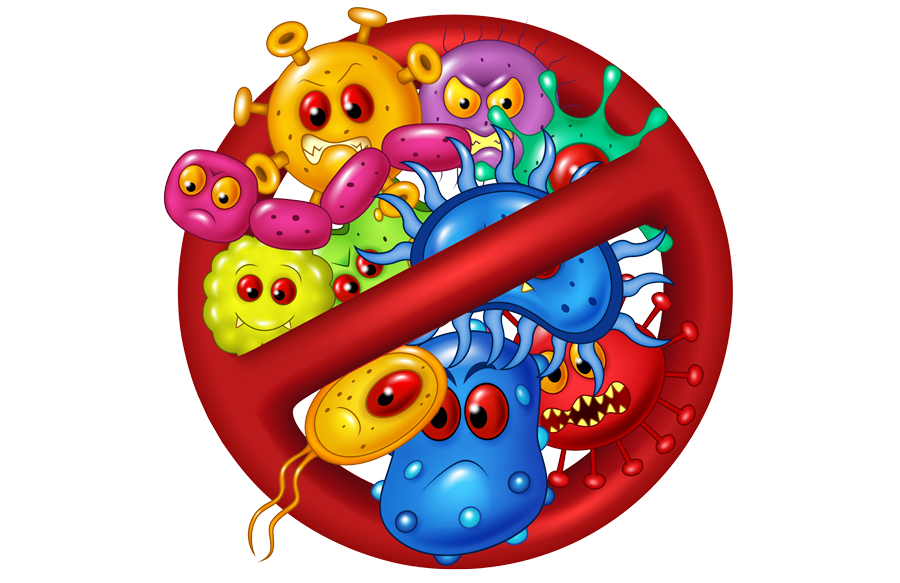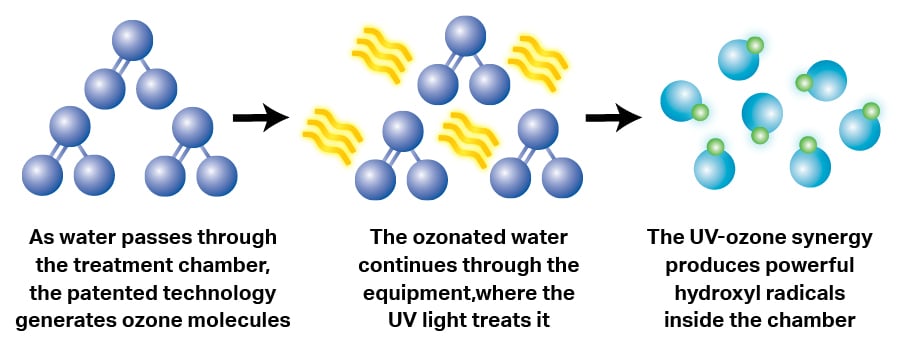—AOP systems safely and effectively help disinfect water without the typical chlorine aggravation

With advanced oxidation process (AOP)—a remarkably powerful and efficient method for helping disinfect swimming pools—you can have swim-ready water without the harsh effects of typical chlorine sanitizing treatments.
This potent treatment safely neutralizes a wide range of contaminants in pool water—including some dangerous pathogens that traditional chlorine treatments cannot tackle.
AOP systems have been used successfully for years in large commercial water-treatment facilities, including those that produce water we drink. Recently, this technology has been adapted for backyard pools, and the results are paying off for pool owners across the country.
What is Advanced Oxidation Process?
Used in tandem with a small amount of chlorine, AOP works by oxidizing both organic and inorganic matter that contaminates swimming environments.
Oxidation may sound like a complicated scientific term. But it’s a basic process that occurs all the time in nature. Have you ever wondered why an apple turns brown after you peel it? That’s oxidation in action.
In a nutshell, oxidation is the loss of electrons which causes a substance to break down. Chlorine—the most widely used pool sanitizer—also works through oxidation.
How AOP works in swimming pools
AOP delivers better results than off-the-shelf chlorine alone. For starters, it provides three times the oxidation potential as chlorine.
It’s also more lethal than two other popular alternative water sanitizers: ozone—a triple-charged form of oxygen—and ultraviolet light (UV). Bottom line, you cannot find another pool sanitation tool that packs the same wallop as AOP!
An AOP system produces ozone molecules, and then it zaps them with UV rays inside an enclosed equipment chamber. This action produces elements known as hydroxyl radicals.
Hydroxyl radicals may sound a little intimidating, but they are completely harmless to swimmers. Time for a quick science lesson: Hydroxyl radical ions form when an oxygen atom bonds with a hydrogen atom.
While AOP devices produce hydroxyl radicals using technology, these elements also exist in nature. In fact, scientists often refer to hydroxyl radicals as a kind of "detergent" for the atmosphere. That's because they help eliminate many airborne pollutants, including greenhouse gasses such as methane.
Why hydroxyl radicals attack contaminants
Because hydroxyl radicals are unstable, they seek equilibrium. So as soon as they form, hydroxyl radicals seek out both organic and inorganic substances to combine with to help them stabilize.
By attaching to the cells in other various substances, hydroxyl radicals disrupt the composition of those substances—causing them to break down. That’s what makes hydroxyl radicals so effective at removing contaminants.
Even better: They complete their work without any chemical after-effects. Once in the pool water, hydroxyl radicals oxidize all contaminants in the water in mere seconds. Then, they simply convert back to oxygen.
This process makes hydroxyl radicals completely safe for pool users while providing fresher, healthier water than any other pool-disinfection weapon.
How AOP devices work: Pairing ozone with
ultraviolet light produces hydroxyl radicals.

10 benefits of hydroxyl-based pool sanitation
Growing numbers of pool owners are seeking alternatives to standard chlorine treatments—and the hassles and hazards they often cause.
Driven by this demand—coupled with technological advances that have lowered the price tags on AOP systems—this technology is becoming increasingly popular in backyards around the country.
Let’s look at the key reasons AOP systems are quickly becoming a favorite choice for maintaining clean, healthy water conditions.
1. Unmatched cleaning power:
AOP systems easily outperform other pool-water treatment methods, including chlorine, salt-chlorine generation, ozone, and ultraviolet light. AOP’s hydroxyl radicals destroy 99% of organic and inorganic contaminants in pool water.
Hydroxyl radicals also prevent the formation of icky biofilm. Biofilm is an accumulation of slimy, bacterial colonies that sticks to areas of a pool such as the tile line and any stone surfaces. Hydroxyl radicals also inhibit growth of stubborn algae blooms as well.
2. Greater water clarity:
AOP technology remove the colloids—tiny particles from dissolved metals, gels, lotions, and other inorganic substances—that make the water look cloudy.
It’s worth noting that your pool filter cannot remove all of these compounds. But AOP systems enable your filter to achieve what is typically impossible: AOP produces “micro-flocculation,” a process of aggregating tiny particles into clumps.
Although these clumps are not visible to the human eye, they are big enough for your pool filter to trap and remove from the water. So, instead of a hazy pool, you get brilliant, sparkling water!
3. Comprehensive disinfection:
AOP’s hydroxyl radicals fully oxidize all kinds of organic contaminants. The range includes sweat, body oils, bacteria, viruses, human waste, and toxins such as pesticides.
AOP also outperforms chlorine on some important fronts. Among the nasty bugs that chlorine cannot eliminate: E. coli, Giardia, Listeria, Salmonella, Legionella, Pseudomonas, and Cryptosporidium parvum (aka “Crypto”).
However, AOP technology has the power to take down these chlorine-resistant microorganisms. For example, it goes after the Crypto parasite by destroying its cell walls. No other pool disinfectant currently in use is as effective in protecting against this serious health threat.
4. Safer, gentler sanitization:
AOP is lethal to unwanted microorganisms, but not to people and pets who enter the pool. It removes contaminants with no effect on swimmers.
Its efficacy comes without producing toxic byproducts, making AOP much gentler than traditional chlorine treatments. Chlorine creates chloramines—harsh byproducts that wreak havoc for pool users with bleach-like odors, itchy eyes, dry skin, sore throats, parched rough hair, and faded swimsuits. Highly sensitive swimmers may even experience nausea or vomiting.
Unlike chlorine, AOP does not produce these irritating byproducts and the rash of physical side effects that often accompany them. In fact, AOP destroys chloramines, removing some of the unwanted effects they cause.
5. Faster performance:
Within the first 24 to 48 hours of using AOP, hydroxyl radicals clean, sanitize, and micro-flocculate the water. They work in seconds to oxidize contaminants. Virtually instantaneously, hydroxyl radicals deal a blow to pathogens that chlorine alone would take hours to kill.
6. Lower chemical demand:
AOP pool systems do not eliminate the need for chlorine and other chemicals. However, they dramatically reduce the requirements for them.
In addition, AOP helps boost the overall effectiveness of the small amount of chemicals that are used.
7. Easier on your pool:
AOP systems work using a gentle, but effective process. By helping sanitize water without the usual chlorine levels, the odds decrease for damage to certain pool components and systems. The reason: With traditionally chlorinated pools, it’s easy for the water to fall out of balance.
High chlorine levels lower the pH of the water, making it more acidic. Over time, water with low pH can lead to corrosion of metal piping and certain components of pool equipment. Serious water imbalances can also erode pool plaster.
8. Better water quality:
With lower chemical levels in your pool, AOP-treated water is easier on your eyes, skin, and lungs—making swimming and pool play safer and more enjoyable for everyone.
Due to AOP’s micro flocculent action helping pool filters remove more contaminant particles—including certain metals—many AOP-pool owners say the water not only looks better, it even feels better to the touch.
9. Environmentally safe:
After hydroxyl radicals oxidize organic and inorganic contaminants in the water, they quickly convert back to oxygen. No noxious byproducts are produced or left behind.
This process makes AOP an eco-friendly technology. It disinfects pool water better than any other method without damaging the environment. You can feel good that any water that splashes out of the pool won’t harm nearby plants with caustic effects the way heavily chemical-laden water or saltwater-chlorinated water can.
10. Overall value:
AOP systems deliver maximum sanitation results, and for that, the units’ price tags certainly run more than a bottle of chlorine or bucket of tablets. Initially, this technology also costs more than saltwater, ozone, or combination UV/ozone systems.
The cost for an AOP unit will ultimately depend on the size of your pool. In general, a quality AOP system is priced at a premium.
However, over the long term, AOP’s many advantages make it a very smart investment. For starters, consider the savings on money for chemicals. AOP requires only minimal chlorine: Fewer chemicals going into the pool translates to less money going out of your wallet.
From a pool-ownership perspective, AOP produces immediate payoffs with water that looks great and provides healthier, more comfortable swimming.
The technology ensures softer, crystal-clear water that’s beautiful to gaze at and that’s free of typical chlorine aggravation. For many pool owners, their families, and their pets, this more attractive, more enjoyable pool experience is hard to put any price on!
Should you install an AOP system in your new or remodeled pool?
The sanitation system is one of the most important components of maintaining your aquatic backyard resort. If you’re thinking about building a pool at your home or modernizing an existing one, you will certainly want to consider including an AOP unit in your equipment line up.
Ultimately, your choice in sanitizing systems will come down to the features and benefits that are most important to you and your family: Easier to keep pool water properly balanced? Amount of chemicals required? Wiping out stubborn pathogens? Stunning water clarity? Silky feel of the water? Environmental impact? Comfort in the water? Overall, long-term value?
All of these factors will play an important role in your decision. The fact remains that AOP represents the pinnacle in pool & spa disinfection—the superior technology on the market.
Hydroxyl radicals sanitize quickly and safely, and they will give you polished, healthy sparking pool water like no other system can.




.jpg?width=1490&name=rock-waterfall-slide-pool%20(1).jpg)